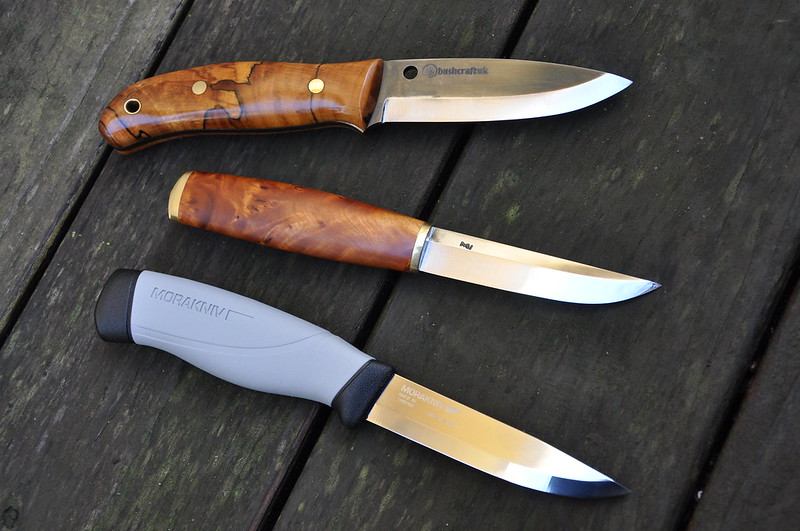- Joined
- Jan 1, 2009
- Messages
- 3,427
Howdy traditional Knife folks.
I hope to set forth some questions without causing a rukkus. After some time here. I believe this can be done in this forum better than some others.
Nothing earth shattering really. I have/had some Scandi Knives. A Kellam Wolverine, that I regret selling. A Helle Harding that was a gift from the bride. So it isn't going anywhere anytime soon.
A few Moras.
And an Aito. Which I grow more fond of with each passing day.
I missed a Brian Andews Puukko on another site this morning. Because I asked a question instead of saying "I'll take it" ya snooze, ya lose. Too bad it was a pretty one.
So with some background info set forth.
Here is my question. What constitutes a real actual Puukko?
In my searches recently. I read the opinion of a Finnish puukko/knife maker.
He suggests that Puukko originate in Finland. Next that they have a high grind. But not more than 75/25% Owing to the fact that a traditional Puukko is a knife designed to be a general purpose blade rather than a specific wood working tool.
He also mentioned that it should be Rhombic in cross section. Meaning a Diamond shaped blade narrow at the edge, widening to a point and than narrowing up again as it approaches the top of the blade.
There may have been more. But they were the points that stood out in my mind.
After missing the one this morning. I sort of have it in my head I will pursue what this gentleman described as a traditional puukko.
Or I may just suck it up and just use my Aito. While I doesn't meet the Rhombic requirement. It is from Finland and it is also a very cool knife it's own right.
The knife maker was keen to point out that. Just because it doesn't fir the classic definition. Doesn't mean it isn't a cool or otherwise great knife.
I figured this may be tha place to ask this. As most traditionals discussed here are governed by certain rules and descriptions that make them such.
Thoughts?
I hope to set forth some questions without causing a rukkus. After some time here. I believe this can be done in this forum better than some others.
Nothing earth shattering really. I have/had some Scandi Knives. A Kellam Wolverine, that I regret selling. A Helle Harding that was a gift from the bride. So it isn't going anywhere anytime soon.
A few Moras.
And an Aito. Which I grow more fond of with each passing day.
I missed a Brian Andews Puukko on another site this morning. Because I asked a question instead of saying "I'll take it" ya snooze, ya lose. Too bad it was a pretty one.
So with some background info set forth.
Here is my question. What constitutes a real actual Puukko?
In my searches recently. I read the opinion of a Finnish puukko/knife maker.
He suggests that Puukko originate in Finland. Next that they have a high grind. But not more than 75/25% Owing to the fact that a traditional Puukko is a knife designed to be a general purpose blade rather than a specific wood working tool.
He also mentioned that it should be Rhombic in cross section. Meaning a Diamond shaped blade narrow at the edge, widening to a point and than narrowing up again as it approaches the top of the blade.
There may have been more. But they were the points that stood out in my mind.
After missing the one this morning. I sort of have it in my head I will pursue what this gentleman described as a traditional puukko.
Or I may just suck it up and just use my Aito. While I doesn't meet the Rhombic requirement. It is from Finland and it is also a very cool knife it's own right.
The knife maker was keen to point out that. Just because it doesn't fir the classic definition. Doesn't mean it isn't a cool or otherwise great knife.
I figured this may be tha place to ask this. As most traditionals discussed here are governed by certain rules and descriptions that make them such.
Thoughts?



